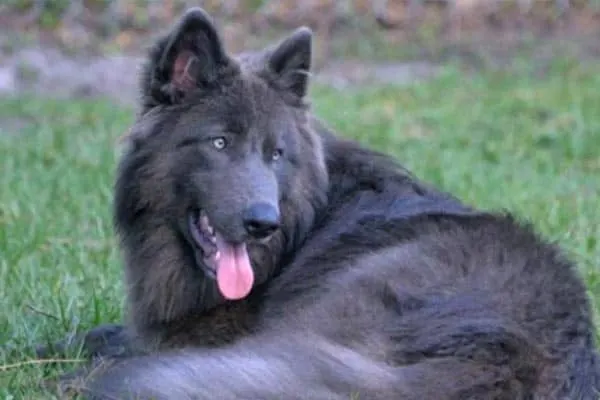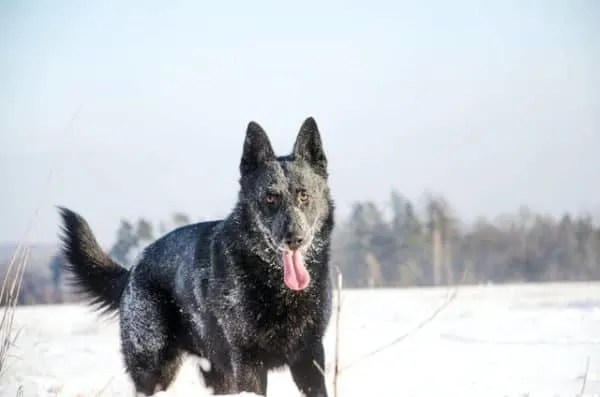The Blue German Shepherd: What Should You Know About It?
A blue German Shepherd is a beautiful dog with gray fur and light-colored eyes, and it has a gene that dilutes its standard color.
Whereas the traditional German Shepherd has a coat pattern of beige and brown, the blue variation possesses a dark blue or grey tint to their coat.
Blue German shepherds’ coats are dark grey or blue compared to the standard GSD colors of black and brown.
Blue Shepherds have the character, health concerns, and physical features standard of the German Shepherd breed despite their unique appearance.
The physical characteristics of a Blue German Shepherd are as follows:
● Height: 22 – 26 inches tall
● Weight: 57 – 90 lbs on average
● Appearance: Medium-large breed, solid athletic build
● Coat: Thick double coat that will shed year-round
● Colors: blue & beige and blue-black
● Temperament: Wise, stubborn, loyal, obedient, curious, attentive, confident, protective, courageous
As each parent dog passes their genes to their puppies, the offspring will have a contributing gene from each parent, so of the two genes that a dog receives, one will dominate the other.
German Shepherds will have two coats, a medium or a long coat. They are both double coats, having a dense guard layer with a softer undercoat.
The undercoat keeps them warm when they are out in service. The appearance of these coats makes them look more grey or black than blue, and the coat color of the GSD does not alter their personality.
Let’s discuss silvering in Blue German Shepherd. Silvering is better known as progressive greying, and it is similar to other color mutation genes.
A puppy will be born black and slowly start turning lighter as early as two years old. Silver produces a beautiful color ranging from silver to grey-blue.
Bluing is more irregular in other breeds, such as the Havanese, and German Shepherds aren’t blue through progressive silvering.
So, how do you register your Blue German Shepherd? Like other German Shepherd colors, you can register a Blue German Shepherd with the American Kennel Club.
However, there are penalties in the conformation show rings for German Shepherds with the recessive dilution gene that creates the blue color.
There isn’t a choice for blue on the German Shepherd Club paperwork when you select your dog’s color.
Blue German Shepherd is a pretty rare dog born through a few genetics, and you might need to wait to get a puppy. The reason behind the rarity of the blue German Shepherd is its genetics.
The double blue recessive gene or two recessive liver genes of the German Shepherd determine their coat color and pattern, and the blue German Shepherd must inherit these two genes.
With reputable breeders, a Blue German Shepherd can cost at least $1500. You can also adopt a dog from a shelter rather than buying one from a breeder.
On average, with rescue costs between $50 and $350, you will also be saving a life.
Blue German Shepherds are beautiful dogs and are relatively easy to train and teach commands.
Like any German Shepherd, the blue version will make a great pet who is loving, protective, and generally a good all-rounder!
What Is A Blue German Shepherd?
Blue German shepherds’ coats have dark blue or grey color variations, making them easy to identify compared to the standard beige/black/brown GSD colors.
But their coats are not always one solid color. More often than not, Blue German Shepherds’ coats will take on of three main variations: blue and beige, blue and sable, and blue and black.
These dogs will also have blue eyes, and thanks to their unique appearance, Blue GSDs are highly sought after.
Someone new to dogs might think they look black or dark grey, but the blue colors will actually shine through when the sunlight perfectly hits their coats.
Quick Facts
| Height | Weight | Appearance | Coat | Health | Family Friendly? | Temperament | Training & Exercise | Price |
|---|---|---|---|---|---|---|---|---|
| 22 - 26 inches tall (males are two inches taller on average) | 55 - 90 lbs on average (males tend to be heavier) | Medium-large breed, strong athletic build, pointed muzzle, slightly downward sloping backs. Can have an intimidating appearance. | Thick double coat that will shed year-round & seasonally. Common colors: blue & beige, blue & sable, and blue & black. | Lifespan: 9 - 13 years. Prone to genetic health issues: hip & elbow dysplasia, degenerative myelopathy, bloat, osteoarthritis. | With the proper upbringing and training - YES! These are great family dogs, there's a reason why they're the 2nd most popular companion canines in America. | Intelligent, stubborn, loyal, obedient, curious, alert, confident, protective, courageous | 1-2 hours daily exercise is highly recommended. These are working dogs that need to stay stimulated and busy to avoid behavioral problems. Training & socialization should begin in puppyhood. | $1500 minimum (from a reputable breeder) |
Blue German Shepherds: How To Interpret Coat Color Genetics
Each parent dog will pass on their genes to the litter of puppies. Therefore, the offspring will have a contributing gene from each parent.
Of the two genes a dog receives from their parents, one will usually dominate the other.
An observable trait that a dog expresses, such as upright ears, is known as the phenotype.
If we label upright ears a dominant trait “U” and lazy ears as recessive “u,” we’re using coding or genotypes.
In a hypothetical example, a GSD with upright ears could have a genotype of “Uu” or “UU,” and a Shepherd with lazy ears would have to be “uu.” Two Shepherds with upright ears could cross as “Uu” x “Uu.”
In a simplistic application of Mendelian genetics and the Punnett Square, 75% of the puppies from the cross would have upright ears and 25% would have lazy ears.
About 50% of the puppies would have the potential of passing floppy ears to their offspring.
Coat colors are very similar to the above example but more complex. A German Shepherd’s coat receives input from genes that dictate the color and pattern.
The agouti family or series of genes, the “a” allele class, accounts for most base GSD colors.
Agouti genes have a cascading order of dominance. Moreover, modifying genes can alter the agouti expression in various ways.
Dominant “Ay”
Depending on the breed, produces fawn or clear, tipped, or shaded sable. The GSD isn’t fawn but can be shaded sable distinguished by a widow’s peak pattern on the head.
Dogs with a dominant gene at “K” will be solid black, regardless of “A.” Dominant black doesn’t appear to occur in the GSD.
Agouti “aw”
Wild or wolf sable – It ranges from prevalent red shades to dark gray.
The intensity gene affects how red a dog is, and the bluing gene can create a pale gray and silver dog. Most sable Shepherds, especially East German and Czech working lines, are agouti.
Tan points “at”
Only dominant over recessive black and the dominance is incomplete in German Shepherds.
Dogs with genetic coding for black and tan points and recessive black will have minimal tan markings and are bi-colors.
The RALY gene
This is a modifier of the black and tan gene, allowing the black on tan-pointed dogs to recede to blankets and saddles on the GSD and other breeds.
People also call the phenomenon creeping tan.
Recessive black “a”
It’s difficult in some cases to tell the difference between shaded sable and agouti, as well as between shaded sable and a black-tan dog with the RALY modifier.
With that being said, any colored dog can exhibit blue if the dilution gene is present.
Agouti colors receive influence from other loci.
These influential alleles include the brown or liver gene, intensity gene, the melanistic mask gene for facial pigmentation, the recessive white gene, the KIT panda gene, the white spotting gene, and the dilution gene for blue and Isabella dogs.
Genes that you won’t see in German Shepherds are the merle gene and the dominant black gene at the “K” locus.
The “K” locus can also produce brindle, a striped pattern we haven’t seen in the GSD since 1922.
What Is The Meaning of Blue For Different Dogs?
Breeders, owners, show judges, and field experts refer to many dogs as blue. The use of the descriptor blue is often breed-dependent because a few mechanisms can produce the color.
Moreover, blue refers to different colors ranging from charcoal gray to steel blue to light silver, depending on tradition.
Progressive Silvering
Better known as progressive greying, silvering is similar to other color mutation genes. A puppy will be born black and then gradually start turning lighter as early as two years old.
Not yet able to identify its exact location, we can mark the greying gene as a dominant allele “G.” Progressive silvering is a dominant trait with a genetic label or genotype of “Gg” or “GG.”
Dogs with “gg” on the greying allele will not develop the premature greying people seek in certain breeds:
- Old English Sheepdog
- Havanese
- Kerry Blue Terrier
- Irish Wolfhound
- Cesky Terrier
- Bearded Collie
- Dandie Dinmont Terrier
- Scottish Deerhound
- Poodle
Silvering, as its name suggests, eventually produces a beautiful color ranging from silver to grey-blue. Fanciers also refer to progressive greying dogs as having a blue coat.
Note in a few breeds, like the Kerry Blue Terrier, the greying gene is universal.
In other breeds such as the Havanese, bluing is more sporadic. German Shepherds aren’t blue via progressive silvering.
Ticking and Roan
Ticking and roan both refer to varying degrees of color on a white coat that gives a speckled or white-flecked appearance, respectively.
Dogs only appear bluish or grayish because of the mixture of white and black hairs.
An unidentified ticking gene is responsible for many forms of spotting and roaning on dogs and is partially dominant.
Recent findings suggest two separate genes may be responsible for roan and ticking as opposed to multiple locations on one gene.
You won’t see a blue roan or blue-ticked German Shepherd unless you have a mix:
- Blue-Ticked Coonhound
- English Setter
- Border Collie
Roaning creates a near-solid pattern, like black and tan, over a white coat, and these dogs appear dusted with white. Where the predominant color is black, a roan dog appears bluish.
Watch this YouTube video about Blue Heeler/Australian Cattle Dog: Mountain Man’s Best Friend.
- Australian Cattle Dog – Excellent example of blue roan. Where the dog has the most white, the black looks lighter, and the entire area has a bluish or grayish cast.
- Cocker Spaniel
- German Shorthaired Pointer
Blue Merle
Like blue-ticked and roan dogs, merle canids aren’t blue. Merle dogs appear bluish because of the swirl of dark and lighter hairs close to each other.
Merles are often several shades of gray along with black that all have the illusion of varying blue hues.
People sometimes confuse merle dogs with roan or ticked dogs. Merle dogs don’t have a white base, but some are ticked.
Merle is a dominant gene, and dogs with a double copy appear to be more susceptible to eye problems and deafness. This gene only affects eumelanin or dark pigment.
Like ticking and roaning, a purebred German Shepherd won’t carry the merle gene.
Dilution Gene
A dilution gene is a modifier at the center of the rare blue German Shepherd.
The dilution gene affects eumelanin or the very dark pigment in black coats.
If a German Shepherd has a saddle and mask that would ordinarily be black, these areas will show up as steel blue in a dog with the dilution gene.
Therefore, blue in a Shepherd can refer to four pattern variations:
- Solid blue
- Blue bicolor – has very minor tan points.
- Blue and tan
- Blue sable
A dilution gene usually is most apparent in the dark parts of the coat. However, the dilution gene also affects pheomelanin.
If a German Shepherd is predominantly reddish or yellow, as in some wild sable or tan dogs, the dilution gene would produce a cream-colored animal.
Note, a cream Shepherd is not genotypically a fawn, even if it has a dark facial mask.
Also, one should be careful not to confuse red and yellow German Shepherds with liver dogs. Red dogs have black noses.
On the contrary, liver Shepherds have light-colored nose leather which reflects the browning gene.
The brown gene has a diluting effect on a dog’s coat and eyes but is distinct from the dilution allele that produces blue.
The liver allows no expression of black, and Shepherds with the brown gene will have yellow or amber eyes.
Adding further to the complexity of color genetics is the intensity gene. This gene affects the brightness and depth of the brown coloration or reds of the dog.
If the intensity gene allows high levels of pheomelanin, traditionally-colored German Shepherds will be vivid, and show judges will reward them.
The intensity gene can suppress pheomelanin and produce pale tan or silver of the German Shepherd’s brown markings. In other breeds, people call silver dogs blue, but this isn’t the case for the GSD.
Silver and blue can be very similar in wild sable dogs where it’s difficult to determine if the lack of red is from decreased intensity or dilution.
The eyes will always give you an idea if the bluing gene is present in Shepherds. Dilution disrupts pigmentation in the iris, so dogs with the blue gene will have lighter-colored eyes.
Is Isabella blue?
Isabella goes by several names, including lilac and mouse-grey, but isn’t technically blue.
The silvery tawny shade, perhaps best illustrated by the Weimaraner, is the effect of the dilution gene on the color liver. Some like to see it as a combination of the “blue gene” and the “chocolate gene.”
Can white German Shepherds be blue?
The dilution gene can affect any color of the standard German Shepherd. Although very rare, the blue gene could theoretically affect a White Shepherd.
White Shepherds have a double copy of the recessive gene “e” which prevents the expression of black. The intensity locus dictates whether any red persists.
If the dilution gene is present, it dilutes both eumelanin and pheomelanin. White dogs with the dilution gene will be snow white with blue or amber eyes.
Their paw pads, lips, eye rims, and nose will retain pigment, unlike albinos, but will be gray instead of black.
How Do You Register a Blue German Shepherd?
Like most German Shepherd colors, you can register a Blue German Shepherd with the American Kennel Club.
In keeping with Max von Stephanitz’s philosophy about the German Shepherd being a good working dog regardless of coat color, the AKC doesn’t forbid registration of any GSD based on color.
However, German Shepherds with the liver gene or the recessive dilution gene that produces either Isabella or blue carry serious penalties in the conformation show rings.
On the paperwork for the German Shepherd Club, there isn’t a choice for blue when you select your dog’s color.
Although mostly basing their criteria on working ability, the SV doesn’t accept white dogs and appears to take a similar stance on blue and liver Shepherds.
Gray is a choice but refers to wild sable or wolf gray.
How To Dispel The Myths Surrounding Blue German Shepherds?
There are many myths surrounding blue German Shepherds based on faulty information and other breeds:
Not purebred dogs – The blue GSD is a purebred dog that has inherited a recessive gene that dilutes the hair coat.
Health problems – Blue Shepherds have no more health problems than a standard colored GSD.
Common issues include dysplasia, vulnerability to gastric torsion, degenerative myelopathy, bleeding disorders, and low thyroid hormones.
Color mutant alopecia is a balding condition of blue Dobermans that blue German Shepherds don’t experience.
Blue isn’t a recognized color in German Shepherds – The AKC recognizes blue German Shepherds; the registry simply faults the color. You can register a blue German Shepherd.
Blue Shepherds have the same color eyes as standard Shepherds – The dilution gene affects eye pigmentation and blue dogs have light eyes, most commonly blue.
Isabella dogs often have the same amber eyes as liver dogs.
Blue Shepherds have been crossed with Weimaraners or Blue Heelers – Again, the blue GSD is a purebred dog.
Dilution only affects dark colors – The dilution gene responsible for blue in Shepherds also gives the red-based colors a washed-out or muddy appearance.
The liver gene, on the other hand, only affects eumelanin.
Blue dogs are more aggressive – Blue German Shepherds don’t exhibit any differences in disposition, work ethic, or drive compared to standard Shepherds.
Is The Blue German Shepherd The Dog For You?
Blue in German Shepherds is a color variation that is the result of a dilution gene that works most noticeably on the dog’s black coloration.
However, the so-called bluing gene also works on red, and blue dogs with tan points that will show dampened or muddied shading.
Since eumelanin is responsible for the dark pigmentation in brown eyes, the dilution gene will usually produce blue eyes.
This is one of the best examples of a blue German Shepherd. At 11 weeks, this blue and tan puppy has a definite off-black coat that looks blue-gray when exposed to light.
His eyes are blue and you can see how his tan markings are very pale. He is young, so his eyes could eventually change to amber.
Frequently Asked Questions
What is a blue German shepherd?
A blue German shepherd is a one-color variation of the German Shepherd breed.
Unlike the traditional German Shepherd coat pattern of beige and brown, the blue variation has a dark blue/grey color of their coat.
Their coats are not always one solid color; however. There are three variations of the coats, including blue and beige, blue and sable, and blue and black. Blue German Shepherds also have blue eyes.
Blue German Shepherd are incredibly sought after by owners due to their uncommon looks.
To the untrained eye, they might look black or dark grey, but when the light hits their coat in the right way you can see their blue undertones.
How rare is a blue German shepherd?
Blue German Shepherds are very rare dogs because they are only born through a distinct few genetics.
The rarity of these dogs means that you’ll need to spend a little more on them than you would for a beige and brown German Shepherd.
You might also have to be put on a waiting list before you can meet your new blue german shepherd puppy.
The blue German Shepherd is rare because its color is determined by its genetics. Two genes of the German Shepherd determine their coat color and pattern.
The blue German Shepherd needs to inherit the double blue recessive gene or two liver recessive genes.
There is no telling how likely a dog is going to inherit these genes, but it is definitely less common than the dominant genes of beige and brown colorings.
When blue German Shepherds are bred, it’s not guaranteed that all of the offspring will be blue as well.
This means that you might be on a waiting list for a very long time.
How much is a blue German Shepherd puppy?
Due to the fact that blue German Shepherds are a rare breed, you can expect to pay more for them than you would a common German Shepherd.
When choosing your breeder, you’ll want to make sure that they are reputable and trusted.
While you might get a slightly lower price with an unverified breeder, they shouldn’t be trusted and you might find that your dog suffers from health issues later on in their life.
With reputable breeders, the cost of a blue German Shepherd will often be at least $1500. This is if you’re buying your puppy from a breeder rather than adopting a dog from a shelter.
The American German Shepherd Rescue Association has a number of listed rescue centers that have German Shepherds staying with them that you can adopt.
They also have a way to search for blue German Shepherds so that you can find one near you.
The average cost of adopting a dog from a rescue shelter is between $50 and $350, which is much lower than the cost of buying from a breeder.
Plus, you might be saving a dog’s life if they are staying in a kill shelter!
Are blue German shepherds aggressive?
No, blue German Shepherds are not considered aggressive as long as they have been properly trained and socialized when they’re young.
This is unfortunately a common misconception that German Shepherds are aggressive because they’re often associated with police and military dogs, which can act aggressively when prompted.
This makes some people associate German Shepherds with aggressive behavior, but this isn’t the case the majority of the time.
German Shepherds are rather easy to train and you can teach them commands such as ‘quiet’ and ‘recall’ to ensure that you remain in control if your blue German Shepherd begins to exhibit signs of aggression.




































